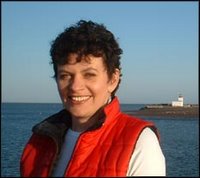
1. What types of fish are caught in the weir?
Herring first (May, early June) then Mackeral and Shad
2. Does the weir operate yearround?
No, the fish run in the spring and early summer. The weir is not fished in the warmer weeks of summer (later July and August). Before winter, the nets are completely removed to avoid damage by ice cakes. The nets are re-strung in April.
3. Do you need a license to have a weir?
Yes, Alan has a Dept of Fisheries license just like any other commercial fisherman. This insures that no other weir is set in close proximity. Alan has carried the license in this location for about 20 years but a weir in this location dates back to about 1880. There are a couple other small weirs about 15 miles away in Five Islands but no others anywhere nearby.
4. How much time do you have to get the fish out before the tide comes back in?
This varies with every tide (the highest tide times of the month are also the lowest tides) but generally the boys are in the weir with their hip waders about an hour before low tide and an hour after it.
5. After all the fish have been scooped why is the floor of the weir swept free of fish scales, etc.
Over the years Alan has noted that if he does not "clean the barn" with each tide then he does not catch any fish on the next tide. It's almost as if there is a bad vibe for the fish with a mess around.
6. Do you ever catch anything else in the weir ? Occasionally a few other types of fish are caught, like cod, but this weir has been purposely designed to follow the natural instincts of herring and mackeral. As the tide rises they swim across the shoreline until they are guided by the weir's nets into its figure-8 section. Herring and mackeral naturally swim in a figure-8 pattern so they are content to swim around in the weir without venturing back out the wide opening. Sea mammals such as seals or porpoises would figure out how to leave 'by the main entrance' and are therefore not caught. If they were, the weir is equipt with a handy trap door at its base on the water side that would enable their safe release.
Monday, June 04, 2007
Bay of Fundy weir fishing FAQs
Subscribe to:
Post Comments (Atom)






1 comment:
It is important to point out that weir fishing in the uppermost part of the Bay of Fundy is quite different from the one videoed in this blog. In Five Islands and Economy, weir posts are 9 - 10 ft. in length, with 3 ft driven into the floor of the bay at low tide, leaving 6 - 7 ft exposed. Up to 900 poles can be used. The "bosom" of the weir is usually higher than those at the ends of the wings. These weirs can be 1/4 mile in length consisting of 2 wings and a trap. The trap is perhaps 7 x 7 sq.ft. at most. Wire birch and are often woven along the tops of the weir and softwood brush along the bottom. They are located up to one mile off shore on the bottom of the sea and as the tide recedes the fisherman drives in his pick-up or ATV and cart arriving before the tides leaves the weir in order to throw back species not permitted into the outgoing tide. Species permitted are herring, mackerel, shad, gaspereau, and a local favourite, flounder. Can you imagine trying to wrestle with an 8ft. sturgeon covered with boney plates to release it before the tide disappears! Each year new poles are cut and new holes are made in the mudflats in which they are inserted. James Webb at Economy Cove until very recently, constructed a traditional MiK'maq weir made only of poles, hardwood and softwood brush. In the mid 1800's over 20 weirs adorned the mudflats from Lr. Economy to Economy Point with names such as Cheverie, Win the Day, The Nest, Grab-All, Long Green, Grizzle Barrow, etc.
Copies of "The Woven Weirs of Minas" can be purchased at Cobequid Interpretive Centre, Economy.
Post a Comment